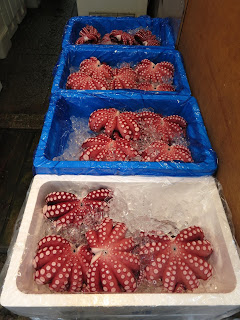We got up early to visit the Tsukiji Fish Market (Tokyo Central Wholesale Market), which is the largest wholesale fish and seafood market in the world. Open 6 days a week from 5a-10a, 15,000 restaurateurs and food sellers buy 450 types of sea produce from 1,700 different stalls. We were tired from the day before, so we didn't get there at 4:30am to be able to watch the tuna auctions, which apparently are the best attraction. Our experience of Japan so far is that people are very courteous - except at the fish market. There are carts and trucks and wheelbarrows who don't stop for pedestrians cruising through the entire place and you are also likely to get fish guts splattered on you as you are walking through. Understandably of course, as everyone there is working on a deadline for their livelihood. We are lucky that they allow visitors in at all.
 |
| Sea Urchin - pretty sure |
 |
| Fish Roe (eggs) |
Despite the fact that we missed the tuna auction, we ran into quite a few very large tuna and tuna remains throughout the market.
If all those dead fish turned off - or on - your appetite, the market area is probably the best place to get some of the freshest sushi around (go figure). We waited in a very long line to eat at what is considered to be the best in the area. I had the yellowtail and fatty tuna, and Kenny surprised me again by getting the special (red tuna, prawn, crab and roe). Although neither he nor I ate much of the roe. Best sushi yet.
 |
| Waiting for sushi |
Around the market are hundreds and hundreds of vendors selling everything from cured fish, vegetables, drinks, tea, Japanese pottery, really expensive sushi knives and everything in-between. Fun to walk around and look at everything for sale.
After we had our fill of fish, we made our way to the last stop on our Tokyo tour. The Imperial Palace - home of the Emperor and his family. Unfortunately, the main grounds are closed on Mondays, but you can still get good views of the palace and some gardens. The grounds were initially developed as early as 1590, however much was bombed in WWII, so the Imperial Palace as it stands now was re-built following the war. The emperor opens the doors of his house to the public on New Years Day and his birthday (December 23rd). The double-arched stone bridge seen in the foreground of the palace is called the Nijubashi, constructed in 1888.
The grounds and gardens are also quite impressive from what I could see from the gates. I am excited to get back and walk the grounds further. Although tranquil and beautiful now, the areas around the palace have been the place of shelter for victims of the 1923 earthquake, ritual suicide of many Japanese war officers in 1945, and of violent protests in the 1950's and '60's.
That's all for now! We move into our house at the end of this week, which I am very excited about, however it means no internet for 1-2 weeks. Boooooo to that. Look for pictures of the house soon!


























No comments:
Post a Comment